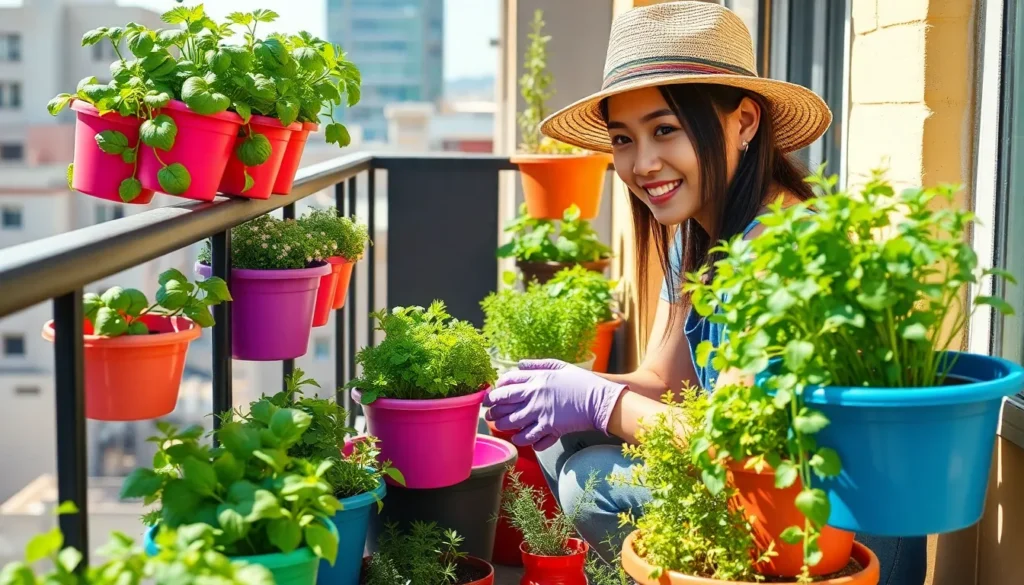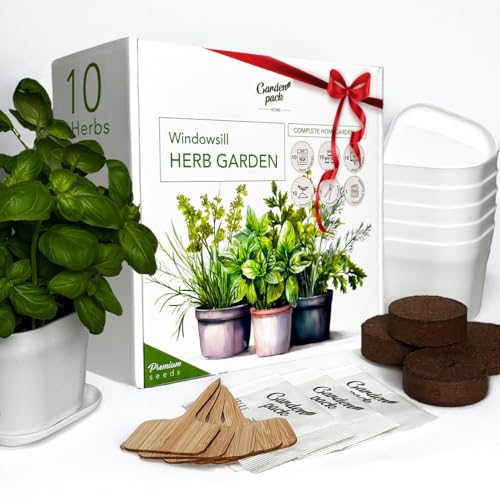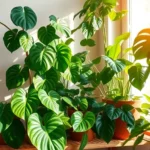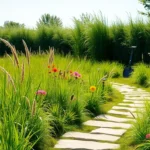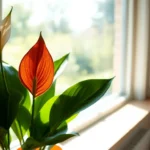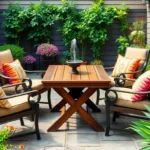Growing fresh herbs doesn’t require acres of land or even a traditional garden bed. Whether you’re living in a cramped apartment or working with a tiny backyard, we’ve discovered countless ways to transform even the smallest spaces into thriving herb gardens that’ll supply your kitchen year-round.
The beauty of herb gardening lies in its flexibility. Most culinary herbs actually prefer contained environments where you can control their growing conditions. From windowsill arrangements to vertical wall gardens, these compact growing answers maximize your harvest while minimizing your footprint.
We’ll show you how to turn forgotten corners, unused balcony space, and even indoor areas into productive herb sanctuaries. These space-saving techniques aren’t just practical—they’ll also add natural beauty to your home while keeping fresh basil, rosemary, and thyme within arm’s reach whenever you’re cooking.
Vertical Wall Herb Gardens: Maximize Your Growing Space
Wall gardens transform unused vertical surfaces into thriving herb production areas that make the most of limited square footage.
Living Wall Planters and Pocket Systems
Modular pocket planters offer the easiest entry point into vertical herb gardening. These fabric or plastic systems feature multiple growing pockets that hold individual herb plants while maintaining proper drainage. We recommend choosing systems with at least 6-8 pockets to accommodate a variety of herbs like basil, oregano, thyme, and parsley.
Installation requires minimal tools and can be completed in under an hour on most wall surfaces. Mount the system using heavy-duty brackets rated for wet conditions, ensuring each pocket receives adequate water distribution. Most pocket systems work best with lightweight potting mix rather than garden soil.
Irrigation becomes simplified with drip-through designs that water upper pockets first, allowing excess moisture to feed lower plants. This cascading effect reduces water waste while ensuring all herbs receive consistent hydration throughout the growing season.
DIY Pallet Herb Gardens
Wooden pallets create rustic vertical gardens at a fraction of commercial system costs. Choose heat-treated pallets marked with “HT” stamps to avoid harmful chemicals, then sand rough surfaces to prevent splinters during maintenance.
Construction involves attaching industry fabric to the back and bottom of the pallet to contain soil while allowing drainage. Fill each slat opening with quality potting mix, leaving space for root development. We suggest planting smaller herbs like chives and cilantro in upper sections, with larger varieties like rosemary in bottom openings.
Positioning requires a sturdy wall or fence that can support 50-75 pounds when fully planted and watered. Lean the pallet at a slight angle to improve water retention and prevent soil from washing out during heavy rains.
Hanging Basket Arrangements
Tiered hanging systems multiply growing space by suspending multiple baskets at different heights. Use adjustable chains or rope to create 12-18 inch spacing between baskets, allowing adequate light penetration to lower levels.
Plant selection works best with trailing herbs like trailing oregano and creeping thyme in upper baskets, while compact varieties like sage and lavender thrive in lower positions. This arrangement creates an attractive cascading effect while maximizing harvest potential.
Weight distribution becomes critical when planning multi-basket installations. Use ceiling hooks rated for at least 35 pounds per basket when accounting for soil, water, and mature plant weight. We recommend testing installation strength before adding plants to prevent accidents.
Container Herb Gardening: Perfect for Patios and Balconies
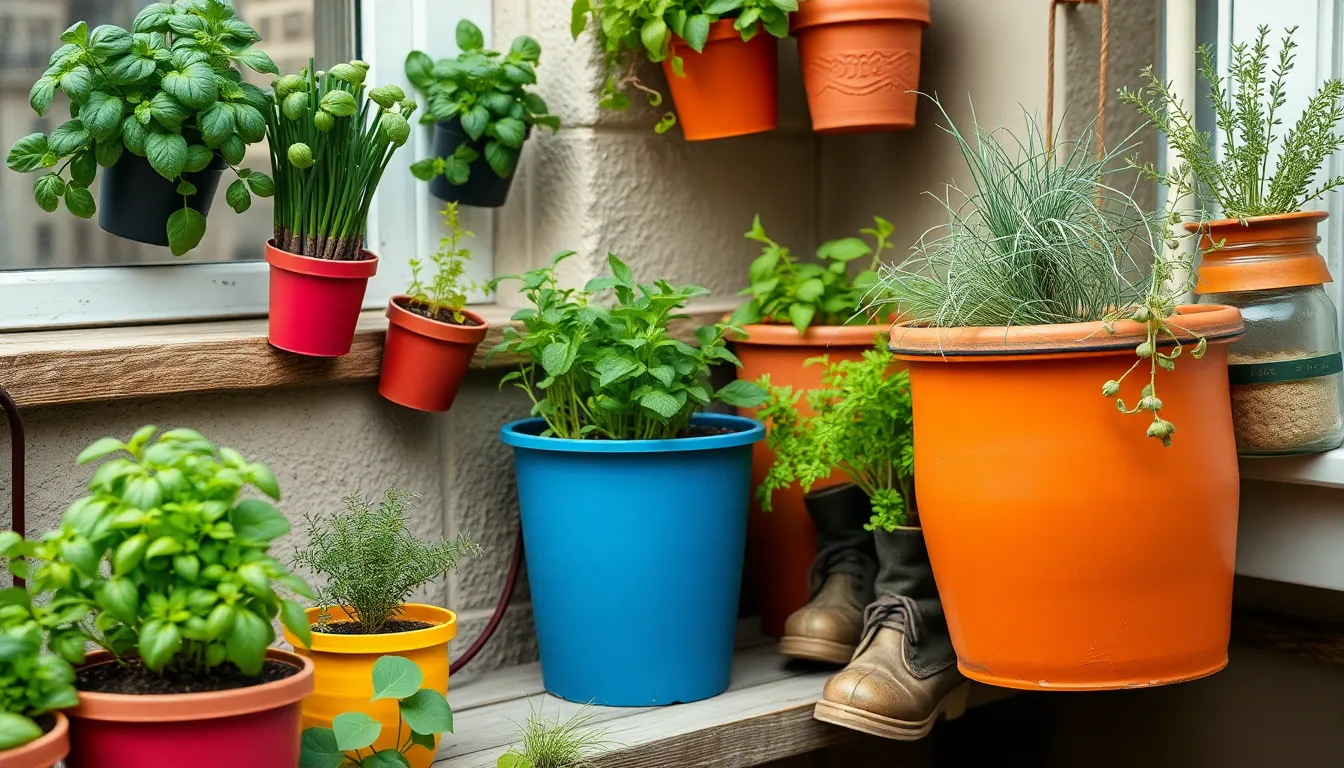
Container herb gardening transforms patios and balconies into productive growing spaces without requiring ground soil. We’ll guide you through selecting the perfect containers and herbs for thriving small space gardens.
Choosing the Right Pots and Planters
Container depth matters most when selecting pots for herbs. We recommend containers that are at least 6-8 inches deep to allow proper root development. Terracotta pots offer excellent breathability for herb roots while ceramic containers provide attractive decorative options for patios. Plastic planters work well for budget-conscious gardeners and retain moisture longer than other materials.
Drainage holes prevent root rot and waterlogged soil. Every container needs holes in the bottom to allow excess water to escape. We suggest adding a layer of perlite or lava rocks at the bottom for improved drainage in your herb containers.
Best Herbs for Container Growing
Basil thrives in containers and produces abundant harvests throughout the growing season. This popular culinary herb adapts well to pot restrictions and provides fresh leaves for cooking. Chives grow compactly in small spaces and offer both leaves and edible flowers for your kitchen.
Cilantro grows quickly in containers and works perfectly for successive plantings. We can harvest cilantro leaves continuously while allowing some plants to bolt for coriander seeds. Thyme develops into a compact bushy plant that tolerates container constraints excellently.
Blue Boy Rosemary stands out as an ideal container herb for small spaces. This variety grows slowly and maintains a compact size, making it perfect for balcony gardens. Regular pruning keeps these herbs healthy while providing fresh ingredients for our cooking.
Creative Container Ideas and Repurposing
Vertical gardening maximizes growing space using trellises and wall-mounted planters. We can create stunning herb displays by mounting containers on walls or fences. Tiered planters stack pots of different sizes to build multi-level gardens that use vertical space efficiently.
Repurposing everyday items adds character while reducing gardening costs. Old boots become charming planters for trailing herbs like thyme or oregano. Wooden crates provide rustic containers perfect for grouping multiple herb varieties together. Mason jars work wonderfully for starting herb cuttings or growing small herbs like chives.
Companion planting enhances both beauty and functionality in container gardens. We recommend adding edible flowers like violas to attract beneficial pollinators to our herb containers. These flowering companions also help deter pests naturally while creating visually appealing combinations with our culinary herbs.
Window Box Herb Gardens: Bring Fresh Flavors Indoors
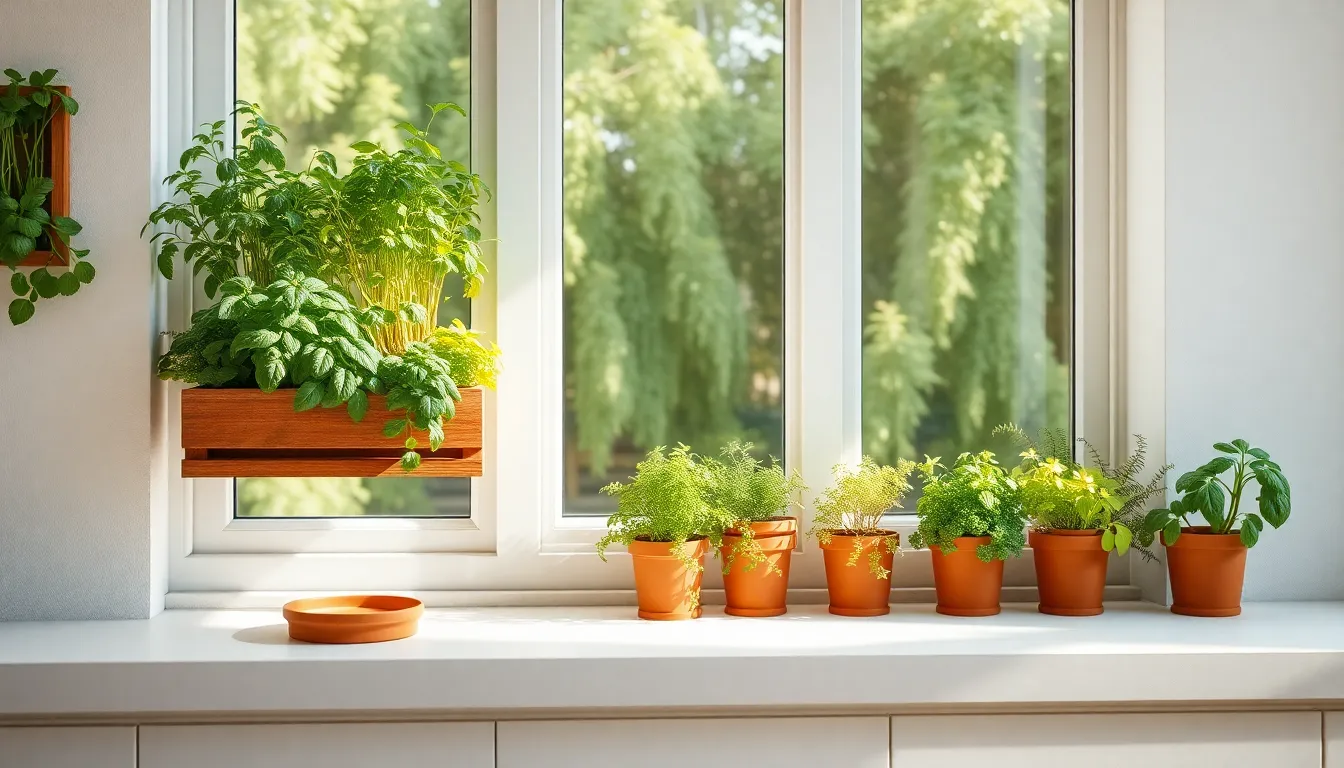
Window box herb gardens transform any kitchen window into a productive growing space that delivers fresh herbs right where you need them most. We’ve found these compact answers perfect for apartment dwellers and homeowners seeking convenient access to culinary herbs.
Kitchen Window Herb Boxes
Kitchen window installations create the ultimate cooking convenience by positioning fresh herbs within arm’s reach of your prep space. We recommend using untreated wood, cedar, or terra cotta containers to establish a natural growing environment that complements your kitchen décor.
Compact herb varieties like basil, thyme, and cilantro thrive in these confined spaces while providing maximum flavor impact. Cedar boxes naturally resist moisture damage and offer excellent durability for long-term use. Terra cotta containers provide superior breathability for root systems and help regulate soil moisture levels.
Installing window boxes directly under kitchen windows brings fresh herbs indoors while maximizing natural light exposure. We suggest incorporating a trellis system for climbing varieties like mint or rosemary to use vertical growing space effectively. Well-draining potting mix with perlite prevents waterlogging that can damage herb roots in contained environments.
Apartment-Friendly Window Answers
Apartment dwellers can maximize limited window space through strategic vertical gardening techniques that don’t require outdoor access. Wall-mounted planters create multiple growing levels while maintaining a compact footprint in small living spaces.
Herbs that grow well in partial shade, such as parsley and chives, adapt perfectly to apartment window conditions with limited direct sunlight. We find these shade-tolerant varieties maintain robust growth even in north-facing windows that receive indirect light throughout the day.
Trellis systems mounted inside window frames provide additional growing space for vining herbs without extending beyond apartment balcony restrictions. Modular pocket planters can be arranged vertically to create a living herb wall that transforms any window into a productive garden space.
Seasonal Rotation Strategies
Spring planting focuses on cool-season herbs like cilantro and dill that prefer moderate temperatures and shorter daylight hours. We transition these early season varieties before summer heat becomes too intense for optimal growth.
Summer months call for warm-season herbs like basil and rosemary that thrive in increased heat and extended daylight periods. These heat-loving varieties produce abundant harvests throughout the warmer months when cooking demands peak herb usage.
Fall transitions bring us back to cool-season herbs that appreciate dropping temperatures and shorter days. Winter strategies involve moving outdoor containers inside or utilizing indoor growing methods to maintain year-round herb production.
| Season | Recommended Herbs | Growing Strategy |
|---|---|---|
| Spring | Cilantro, Dill | Cool-season planting |
| Summer | Basil, Rosemary | Warm-season varieties |
| Fall | Parsley, Chives | Cool-season transition |
| Winter | Indoor varieties | Container relocation |
Indoor winter growing extends the growing season by bringing established herb containers inside heated spaces. We regularly rotate seasonal plantings to ensure continuous fresh herb availability throughout the year while optimizing each variety’s preferred growing conditions.
Tiered and Stacked Herb Garden Solutions
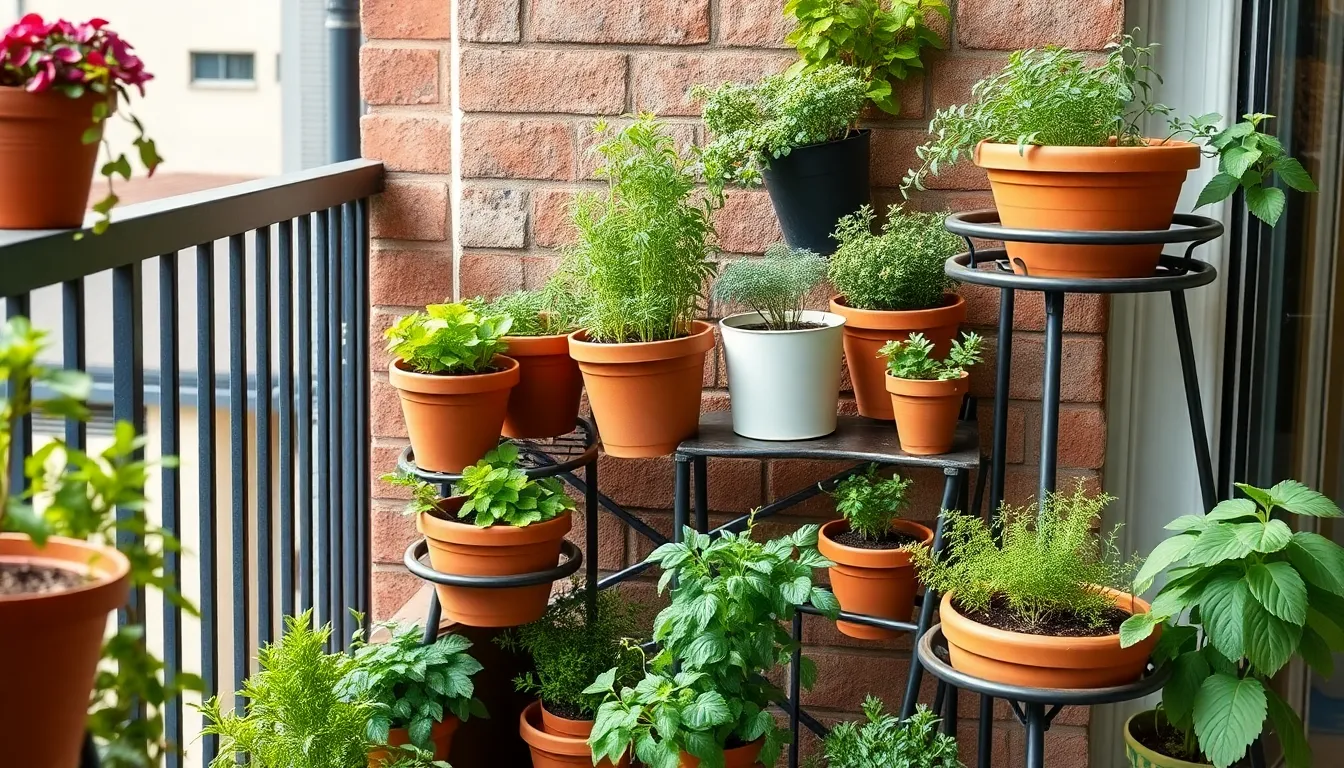
Building upward transforms limited horizontal space into productive growing areas for our favorite culinary herbs. We’ve discovered that vertical herb gardening creates multiple growing zones while maintaining easy access for harvesting and maintenance.
Multi-Level Planter Stands
Multi-level planter stands allow us to grow multiple layers of herbs in a vertical space, maximizing the area available for our small gardens. These structures work especially well for small balconies or patios where floor space comes at a premium.
We recommend positioning taller herbs like rosemary on lower tiers while placing compact varieties such as thyme and oregano on upper levels. This arrangement ensures all plants receive adequate sunlight without creating shadows. Most multi-level stands accommodate 3-5 tiers, giving us space for a diverse herb collection in just 2-3 square feet of floor area.
Stackable Pot Systems
Stackable pot systems enable us to stack individual containers on top of each other, creating a compact and efficient herb garden solution. We can easily move or rearrange these systems as our needs change throughout the growing season.
These modular designs typically feature built-in water reservoirs that distribute moisture evenly through each level. We’ve found that starting with herbs requiring similar water needs in each tower prevents over or under watering issues. Popular stackable systems can hold 6-12 plants in a single vertical column, making them perfect for apartment balconies or small patios.
Ladder-Style Herb Gardens
Ladder-style herb gardens provide a step-like structure for pots, allowing us to grow a variety of herbs in a small footprint while adding visual appeal to our spaces. This design creates natural tiers that give each plant adequate light exposure without overcrowding.
We can use repurposed wooden ladders or purchase purpose-built ladder planters designed specifically for herb cultivation. Each rung holds 2-3 pots, and we typically arrange plants by height with trailing herbs like thyme cascading from upper rungs. This decorative element transforms functional growing space into an attractive garden feature that enhances our outdoor living areas.
Indoor Herb Garden Ideas for Year-Round Growing
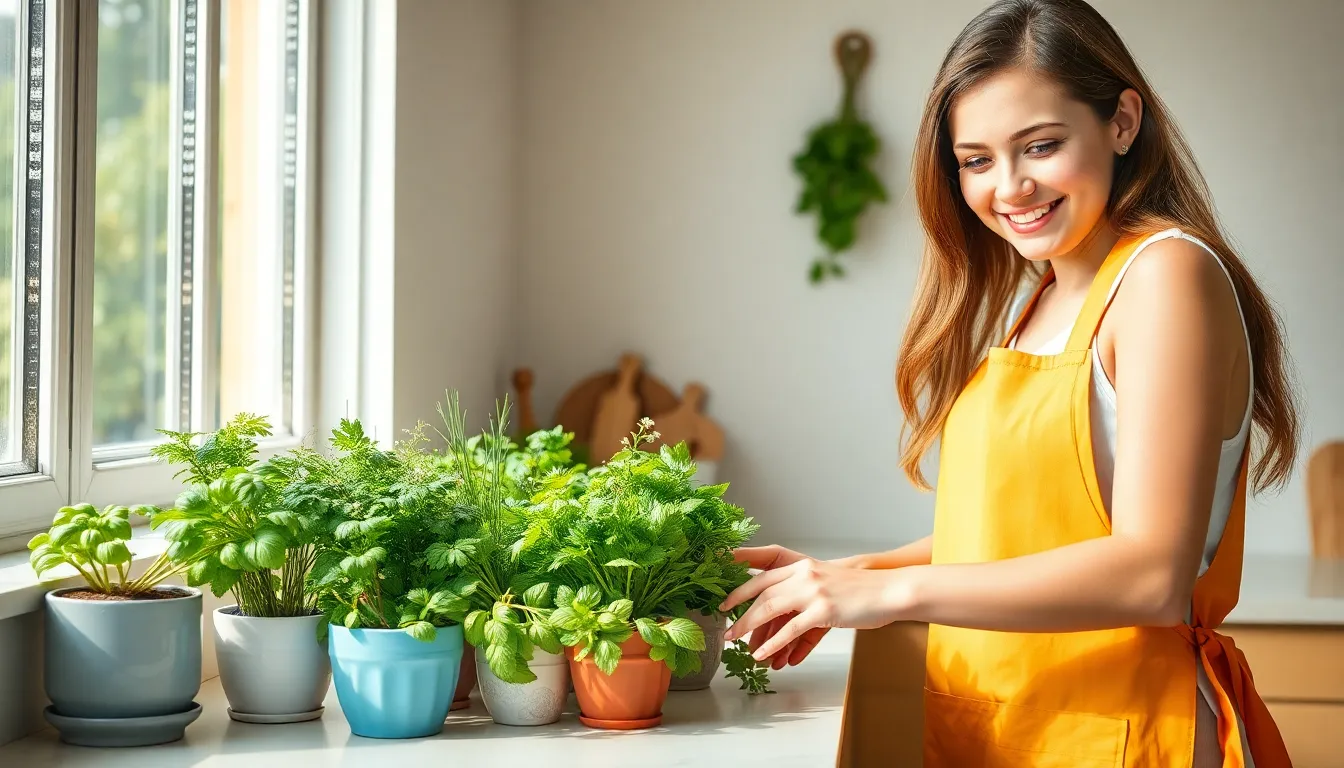
Moving from outdoor growing answers, we can create thriving herb gardens inside our homes that provide fresh flavors every season. Indoor herb cultivation offers complete control over growing conditions while extending our harvest well beyond traditional growing seasons.
Countertop Herb Gardens
Compact planters designed for kitchen spaces bring fresh herbs within arm’s reach of our cooking areas. We recommend selecting containers at least 4-6 inches deep for herbs like basil, chives, and cilantro that thrive in smaller root systems. Self-watering planters with built-in water reservoirs reduce daily maintenance while ensuring consistent moisture levels for optimal herb growth.
Ceramic and terra cotta pots work exceptionally well for countertop growing because they provide excellent breathability for root systems. Small herb varieties like compact basil cultivars, kitchen thyme, and dwarf oregano adapt perfectly to these confined spaces. We suggest positioning these planters near south-facing windows where they’ll receive 4-6 hours of direct sunlight daily.
Modular countertop systems allow us to expand our herb collection as needed, with individual containers that stack or connect for efficient space utilization. These systems often include integrated drainage trays that protect our countertops while maintaining proper moisture control.
Under-Cabinet Growing Systems
LED grow lights installed beneath kitchen cabinets transform unused space into productive growing areas without requiring natural sunlight. We position these growing systems approximately 12-18 inches below cabinets to provide adequate clearance for herb growth while maintaining easy access for harvesting.
Tiered planters or shelf systems maximize vertical space under cabinets, allowing us to grow multiple herb varieties in a compact footprint. These arrangements work particularly well for low-growing herbs like thyme, oregano, and small basil varieties that don’t require extensive vertical space.
Full-spectrum LED strips provide the necessary light wavelengths for photosynthesis, typically requiring 12-16 hours of daily illumination for optimal herb development. We recommend installing timers to automate lighting schedules and maintain consistent growing conditions.
Magnetic planters attach directly to the underside of metal cabinets, creating floating herb gardens that don’t consume any counter space. These innovative answers work best for lightweight herbs and can be easily repositioned as needed.
Hydroponic Herb Setups
Indoor hydroponic systems deliver nutrients directly to plant roots through water answers, often producing faster growth rates and higher yields than traditional soil-based methods. We find that compact hydroponic units fit perfectly on countertops or shelving units while providing controlled growing environments year-round.
Deep Water Culture (DWC) systems use nutrient-rich water answers to feed herb roots directly, eliminating soil-related issues like pests or inconsistent watering. These setups work exceptionally well for fast-growing herbs like basil, cilantro, and lettuce varieties that respond quickly to hydroponic conditions.
Aeroponic systems suspend plant roots in air while delivering nutrients through fine misting, using up to 95% less water than traditional growing methods. We recommend these systems for high-value herbs like saffron, French tarragon, or specialty basil varieties where maximum efficiency justifies the initial investment.
Kratky method setups offer passive hydroponic growing without pumps or electricity, making them ideal for beginners wanting to try soilless cultivation. These systems require minimal maintenance once established and work particularly well for herbs with moderate growth rates like thyme, rosemary, and sage.
Creative Space-Saving Herb Garden Designs
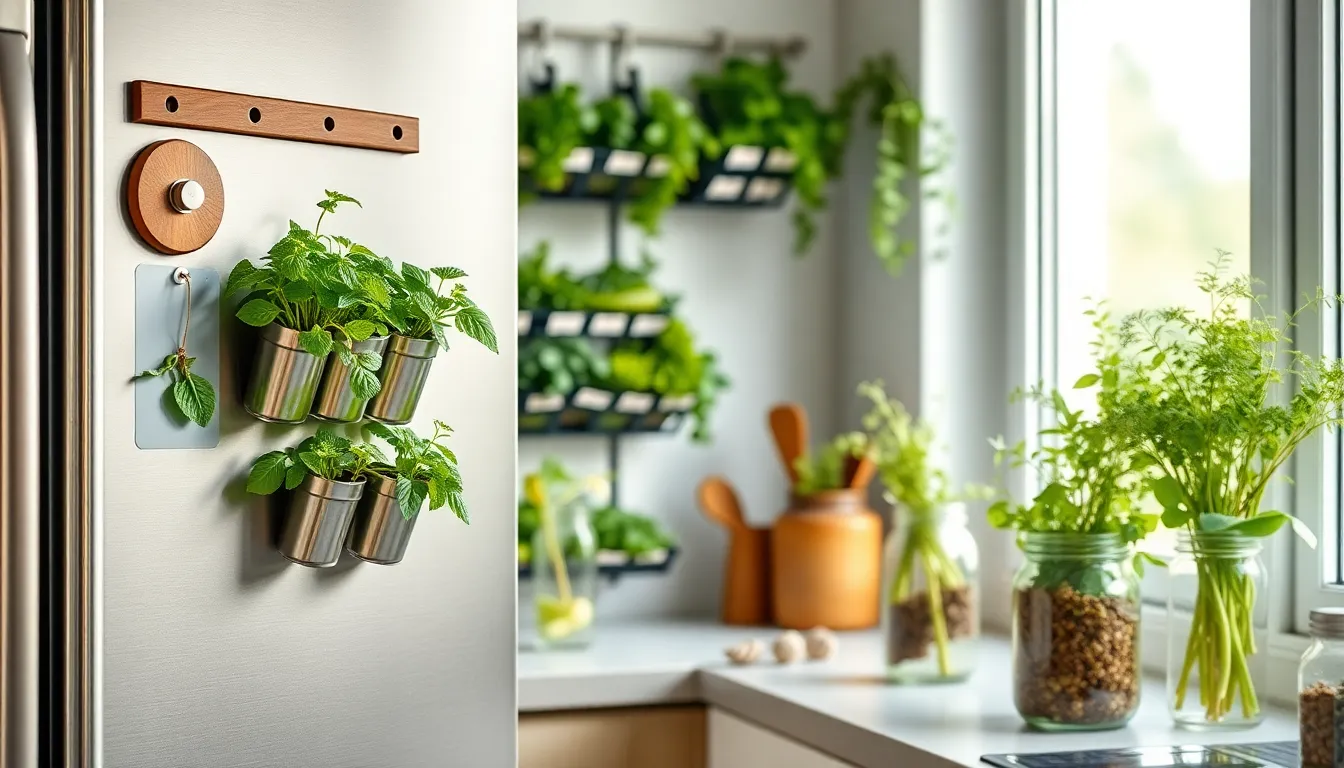
Building on traditional container and vertical approaches, we’ll explore innovative designs that transform overlooked surfaces and everyday items into productive herb growing spaces.
Magnetic Herb Gardens for Metal Surfaces
Magnetic planters transform metal surfaces into instant growing space for urban herb enthusiasts with minimal room to work. We can attach small magnetic containers directly to refrigerators, metal fences, or even outdoor grills to create accessible herb gardens without sacrificing floor or counter space.
Small magnetic planters work best with shallow rooted herbs like basil, mint, chives, and cilantro that don’t require deep soil systems. These herbs naturally thrive in compact growing conditions and adapt well to the limited root space that magnetic containers provide.
Metal surfaces near kitchens offer perfect placement for frequently used culinary herbs like basil and oregano. We recommend choosing planters with strong magnets that can support the weight of wet soil and mature plants without sliding or falling.
Shoe Organizer Herb Gardens
Over the door shoe organizers create vertical herb gardens that maximize growing space in areas as small as a closet door or bathroom entrance. We can hang these fabric organizers on walls, doors, or even outdoor fences to accommodate multiple herb varieties in minimal square footage.
Each pocket accommodates small pots or direct planting with proper drainage considerations for healthy root development. Individual compartments allow us to grow different herbs with varying water and light requirements without cross contamination of soil conditions.
Wall mounted shoe organizers support 12 to 24 herb plants depending on pocket size and herb variety selection. We suggest placing frequently harvested herbs like parsley and chives in easily accessible middle and lower pockets while reserving top sections for occasional use herbs like sage or rosemary.
Mason Jar Herb Garden Displays
Mason jar displays combine functionality with decorative appeal for herb gardens that enhance kitchen aesthetics while providing fresh ingredients. We can arrange these glass containers on windowsills, floating shelves, or hanging installations to create attractive herb growing systems.
Glass jars work exceptionally well for water rooting herbs like basil, mint, and cilantro that propagate easily from cuttings. Fresh herb stems placed in water filled mason jars develop roots within 7 to 10 days and continue growing for several weeks with regular water changes.
Decorative elements like twine, ribbons, or metal bands transform simple mason jars into rustic design features that complement farmhouse or cottage kitchen styles. We can group jars of varying sizes to create ever-changing visual arrangements while maintaining easy access for daily harvesting and maintenance.
Essential Tips for Successful Small Space Herb Gardening
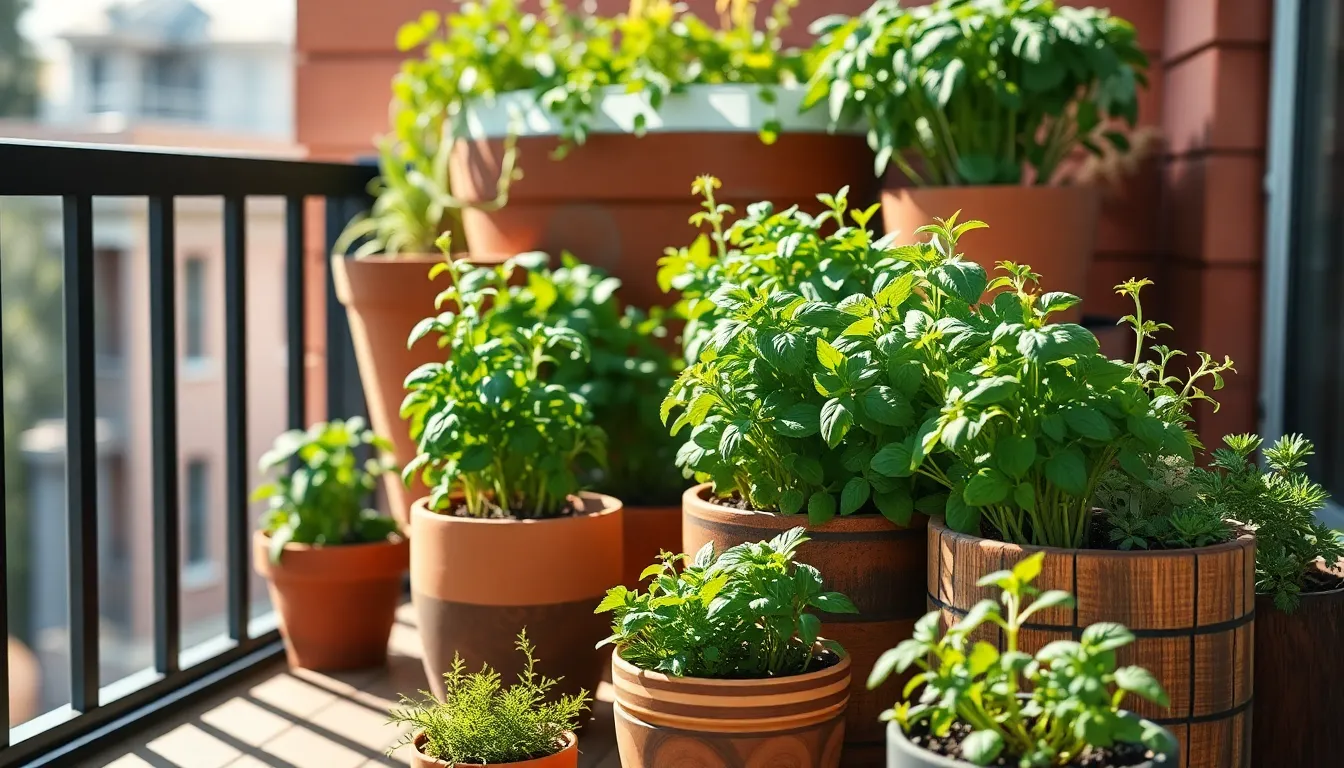
Success in small space herb gardening depends on mastering three fundamental elements that directly impact plant health and productivity. Getting these basics right ensures our compact herb gardens thrive regardless of location or container size.
Soil and Drainage Requirements
Quality potting soil forms the foundation of successful container herb gardening, especially when we’re working with limited space. We recommend using well draining, nutrient rich potting mixes specifically designed for containers rather than garden soil, which compacts easily and prevents proper water movement in small spaces.
Drainage holes become critical when growing herbs in containers, as waterlogged soil leads to root rot and plant failure. Every container in our herb garden needs adequate drainage openings at the bottom, and we often add a layer of perlite or lava rocks to improve water flow through the soil.
Container materials like cedar, steel, and terra cotta naturally promote healthy drainage while providing durability for long term herb growing. These materials allow excess moisture to evaporate while maintaining the soil structure our herbs need for optimal root development.
Light Requirements and Answers
Most culinary herbs require 4 to 6 hours of direct sunlight daily to produce the flavorful oils we want in our cooking. Positioning containers near sunny windows or on south facing balconies maximizes natural light exposure for indoor and outdoor growing spaces.
LED grow lights supplement insufficient natural light, particularly useful for year round indoor herb production. We position these lights 12 to 18 inches above plants and run them for 12 to 14 hours daily to replicate optimal growing conditions.
Strategic placement becomes essential when working with limited space, so we rotate containers weekly to ensure even light distribution among all our herbs. Moving smaller pots to higher shelves or hanging positions captures more available sunlight throughout the day.
Watering and Maintenance Strategies
Watering frequency depends on checking soil moisture rather than following rigid schedules, as container herbs dry out faster than ground planted varieties. We test the top inch of soil with our finger and water when it feels dry to prevent both overwatering and drought stress.
Regular pruning encourages bushy growth and prevents herbs from flowering prematurely, which reduces leaf production and flavor intensity. Pinching off flower buds and harvesting outer leaves keeps plants compact and productive in small containers.
Balanced fertilization maintains soil nutrients without overwhelming herbs with excessive growth stimulants. We apply diluted liquid fertilizer every 2 to 3 weeks during growing season, avoiding over fertilization that can damage delicate herb root systems and reduce essential oil concentration.
Conclusion
We’ve shown that limited space doesn’t have to limit your herb gardening dreams. Whether you’re working with a tiny balcony windowsill or unused wall space these creative answers make fresh herbs accessible to everyone.
The key to success lies in choosing the right approach for your exact situation. Vertical gardens maximize height while containers offer flexibility and indoor options keep herbs growing year-round.
Start small with one or two herb varieties that you use most often in cooking. As you gain confidence and experience you can expand your setup using the techniques we’ve shared.
Your fresh herb garden awaits – it’s time to transform those overlooked spaces into productive growing areas that’ll enhance both your cooking and your home’s appeal.
Frequently Asked Questions
What herbs grow best in small containers?
Basil, chives, cilantro, thyme, and compact rosemary varieties like Blue Boy are ideal for container growing. These herbs have shallow root systems and adapt well to confined spaces. They require containers at least 6-8 inches deep for proper root development and thrive in controlled environments where watering and light conditions can be easily managed.
How deep should containers be for herb gardening?
Most herbs need containers that are at least 6-8 inches deep for healthy root development. Shallow-rooted herbs like basil and cilantro can thrive in 4-6 inch deep containers, while deeper-rooted herbs like rosemary require larger pots. Proper container depth ensures adequate root space and prevents stunted growth in small space gardens.
What’s the best way to maximize vertical space for herbs?
Vertical wall gardens using modular pocket planters, DIY pallet gardens, and hanging basket arrangements are excellent for maximizing space. Tiered planter stands, stackable pot systems, and ladder-style gardens also build upward rather than outward. These methods can triple your growing capacity while maintaining easy access to fresh herbs.
Can I grow herbs indoors year-round?
Yes, indoor herb gardening allows year-round cultivation using countertop planters, under-cabinet systems with LED grow lights, or hydroponic setups. Choose compact varieties and ensure adequate lighting (6-8 hours daily). Self-watering planters and modular systems make indoor growing more manageable while providing constant access to fresh herbs for cooking.
What container materials work best for herb gardens?
Terracotta pots offer excellent breathability, ceramic containers provide aesthetic appeal, and plastic pots retain moisture well. All containers must have drainage holes to prevent root rot. Adding perlite or lava rocks improves drainage. Choose materials based on your climate, watering schedule, and aesthetic preferences while ensuring proper drainage.
How can I create a herb garden without any outdoor space?
Transform indoor spaces using magnetic herb gardens on metal surfaces, shoe organizer vertical systems, or mason jar displays. Utilize kitchen windows for window box gardens, install under-cabinet growing systems with LED lights, or create countertop herb gardens. These innovative solutions maximize overlooked spaces for productive herb growing.
What are the lighting requirements for indoor herbs?
Most herbs need 6-8 hours of direct sunlight daily. For indoor growing, place containers near south-facing windows or supplement with LED grow lights. Full-spectrum LED lights positioned 6-12 inches above plants provide adequate illumination for photosynthesis. Adjust lighting duration based on seasonal changes and herb varieties’ specific needs.
How often should I water herbs in containers?
Check soil moisture daily by inserting your finger 1-2 inches deep. Water when the top inch feels dry, typically every 2-3 days depending on container size, weather, and herb type. Ensure containers have drainage holes and avoid overwatering, which causes root rot. Self-watering planters help maintain consistent moisture levels.
Can I use everyday items as herb containers?
Yes, repurpose old boots, wooden crates, mason jars, and even shoe organizers for creative herb gardens. Ensure any container has adequate drainage holes and is food-safe if growing edible herbs. These DIY solutions are cost-effective and add personality to your garden while maximizing available space.
What’s companion planting for herb gardens?
Companion planting involves growing complementary plants together for mutual benefits. Add edible flowers like nasturtiums or marigolds to herb containers to attract pollinators and deter pests. Some herbs like basil pair well with tomatoes, while thyme complements most vegetables. This practice enhances garden productivity and natural pest control.

